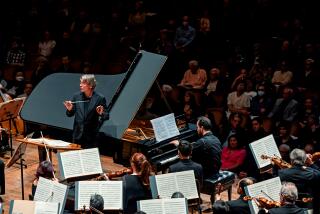MUSIC REVIEW : Verdi Requiem for Rossini Is Reborn in U.S. Premiere
- Share via
NEW YORK — The collaborative Requiem Mass that Verdi planned for the first anniversary of Rossini’s death suffered a death of its own, and now a resurrection more than a century later.
Written in 1869 by 13 Italian composers, the “Messa per Rossini” encountered insurmountable obstacles that prevented its premiere as scheduled, and the work was never heard until German conductor Helmuth Rilling led a reconstruction last year in Germany and Italy.
The United States premiere came Thursday as Rilling led the Stuttgart Bach Choir (Gachinger Kantorei), the New York Philharmonic and a quintet of impressive vocal soloists in Avery Fisher Hall at Lincoln Center in New York.
A performance tonight will be televised at 10 p.m. (PST) on KOCE Channel 50, in Orange County, and at 8 p.m. on KPBS Channel 15, in San Diego. (KCET, Channel 28, in Los Angeles, will not carry the broadcast.)
Conducting from memory, Rilling led an incandescent first performance. But this is not to say that the work is a masterpiece.
With 13 composers involved--each wrote a different movement according to a prearranged plan, and all of them, except for Verdi, have vanished into obscurity--the work is uneven and presents some glaring stylistic differences.
The sudden chromaticisms and expanded orchestration (full brass section--four horns, four trumpets, three trombones and tuba--plus cymbals and gong) in Carlo Pedrotti’s “Tuba Mirum,” for instance, come as quite a jolt after the tamer musical idioms of Antonio Buzzola’s “Requiem” and Antonio Bazzini’s “Dies Irae.”
And who would guess that the saccharine “Lacrymosa” for unaccompanied male voices and the ensuing severe, academic fugal “Amen” are by the same Carlo Coccia, the oldest composer represented in the work?
Even Verdi’s contribution, the “Libera Me,” familiar in its revised form in his “Manzoni” Requiem, offers disconcerting surprise. The earlier version contains passages edited out later, including little brass fanfares in the “Dies Irae” section; correspondingly, there is new material in the later version.
Listeners also will sense something different in parts of the soprano solo, even if not everyone will realize that she is singing a half-tone lower than in the later version.
Perhaps the most obvious and significant difference is that the basses--not the soprano--chant the final “Libera me domine di morte,” ending the work by encompassing mankind communally rather than from an individual point of view as in the revision.
No matter who the composer or what the style, and despite the issue of whether or not they were first-rate, Rilling addressed them all with maximum commitment and insight, and without a trace of condescension.
It is difficult to imagine that there is an ounce of musical expression or possibility that eluded his keen vision. And the results often were electrifying, not only in Verdi’s closing section but also in Buzzola’s “Kyrie” and Pietro Platania’s “Sanctus.”
The Stuttgart chorus, augmented with 14 Americans, sang with alertness, full-bodied tone and responsiveness to the text.
Soprano Gabriela Benackova brought a soaring expressivity to her solo duties, particularly in the “Libera Me.”
Mezzo Florence Quivar sang with power, steadiness and particular urgency in Lauro Rossi’s “Agnus Dei.” (In the televised broadcast, Cornelia Kallisch is scheduled to be the mezzo soloist. Kallisch, a young German singer, was an impressive soloist in Bach’s B-minor Mass led by Rilling on Tuesday at Avery Fisher Hall.)
Tenor James Walker, an American who sang the first performances in Europe, offered an expressive “Ingemisco,” marred at times by some spread tones.
Baritone Jacob Will sang with warmth, power and sensitivity. Bass Brain Matthews, in relatively minor duties, offered solid, strong support. Will and Matthews also are young American singers.
The New York Philharmonic responded to Rilling’s leadership with prismatic transparency, sweetness, suavity, precision and force.
Whether or not the “Messa” takes a place in the repertory, at the least Rilling has made a case that not all of these 19th-Century Italian composers deserve the oblivion into which posterity has cast them.
More to Read
The biggest entertainment stories
Get our big stories about Hollywood, film, television, music, arts, culture and more right in your inbox as soon as they publish.
You may occasionally receive promotional content from the Los Angeles Times.










